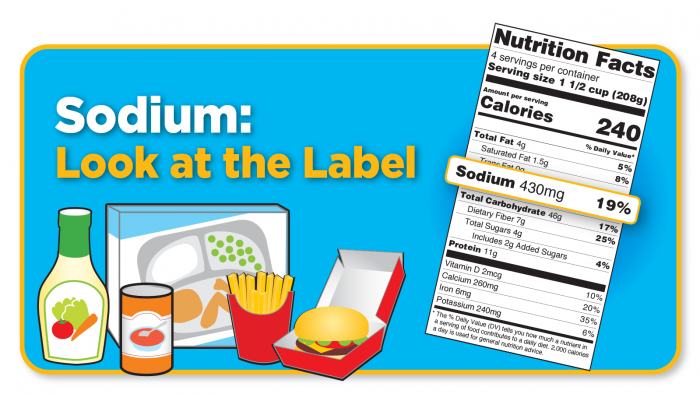Medical Compass: Sodium’s effects on our kidneys
Much of our sodium comes from processed foods, including breads and sauces
By David Dunaief, M.D.

When you hear someone tell you that you should lower your salt intake, how do you respond? Typically, I hear responses like, “I don’t use salt,” “I use very little,” or “I don’t have high blood pressure, so I don’t have to worry.”
Unfortunately, these are rarely true. All of us should be concerned about salt or, more specifically, our sodium intake. Also, approximately 90 percent of Americans consume too much sodium (1).
Why do we care?
We most often hear that excessive sodium in our diets increases the risk of high blood pressure (hypertension), which has consequences like stroke and heart disease.
Now comes the interesting part. Sodium also has a nefarious effect on the kidneys. In the Nurses’ Health Study, approximately 3,200 women were evaluated in terms of kidney function, looking at the estimated glomerular filtration rate (GFR) as related to sodium intake (2). Over 14 years, those with a sodium intake of 2,300 mg had a much greater chance of an at least 30 percent reduction in kidney function, compared to those who consumed 1,700 mg per day.
Why is this study important? Kidneys are one of our main systems for removing toxins and waste. The kidneys are where many initial high blood pressure medications work, including ACE inhibitors, such as lisinopril; ARBs, such as Diovan or Cozaar; and diuretics (water pills). If the kidney loses function, it can be harder to treat high blood pressure. Worse, it could lead to chronic kidney disease and dialysis. Once someone has reached dialysis, most blood pressure medications are not very effective.
How much is too much?
Ironically, the current recommended maximum sodium intake is 2,300 mg per day, or one teaspoon, the same level that led to negative effects in the study. However, Americans’ mean intake is twice that level.
If we reduced our consumption by even a modest 20 percent, we could reduce the incidence of heart disease dramatically. Current recommendations from the American Heart Association indicate an upper limit of 2,300 mg per day, with an “ideal” limit of no more than 1,500 mg per day (3).
Where does sodium hide?
If the salt shaker is not the problem, what is? Most of our sodium comes from processed foods, packaged foods and restaurants. There is nothing wrong with eating out or ordering in on occasion, but you can’t control how much salt goes into your food. My wife is a great barometer of restaurant salt use. If food from the night before was salty, she complains of her clothes and rings being tight.
Do you want to lose 5 to 10 pounds quickly? Decreasing your salt intake will allow you to achieve this. Excess sodium causes the body to retain fluids.
One approach is to choose products that have 200 mg or fewer per serving indicated on the label. Foods labeled “low sodium” have fewer than 140 mg of sodium, but foods labeled “reduced sodium” have 25 percent less than the full-sodium version, which doesn’t necessarily mean much.
Soy sauce has 1,000 mg of sodium per tablespoon, but low-sodium soy sauce still has about 600 mg per tablespoon. Salad dressings and other condiments, where serving sizes are small, add up very quickly. Mustard has 120 mg per teaspoon. Most of us use far more than one teaspoon of mustard.
Caveat emptor: Make sure to read labels on all packaged foods very carefully.
Breads and rolls are another hidden source. Most contain a decent amount of sodium. I have seen a single slice of whole wheat bread include up to 200 mg. of sodium.
If you are working to decrease your sodium intake, become an avid label reader. Sodium hides in all kinds of foods that don’t necessarily taste salty, such as breads, soups, cheeses and salad dressings. I also recommend getting all sauces on the side, so you can control how much — if any — you choose to use.
What about sea salt?
Are fancy sea salts better than table salt? High amounts of salt are harmful, and the type is not important. The only difference between them is slight taste and texture variation. I recommend not buying either. In addition to the health issues, salt tends to dampen your taste buds, masking the flavors of food.
As you reduce your sodium intake, you might be surprised at how quickly your taste buds adjust. In just a few weeks, foods you previously thought didn’t taste salty will seem overwhelmingly so, and you will notice new flavors in unsalted foods.
If you have a salt shaker and don’t know what to do with all the excess salt, don’t despair. There are several uses for salt that are actually beneficial. According to the Mayo Clinic, gargling with ¼ to ½ teaspoon of salt in eight ounces of warm water significantly reduces symptoms of a sore throat from infectious disease, such as mononucleosis, strep throat and the common cold. Having had mono, I can attest that this works.
Remember, if you want to season your food at a meal, you are much better off asking for the pepper than the salt.
References:
(1) cdc.gov. (2) Clin J Am Soc Nephrol. 2010;5:836-843. (3) heart.org.
Dr. David Dunaief is a speaker, author and local lifestyle medicine physician focusing on the integration of medicine, nutrition, fitness and stress management. For further information, visit www.medicalcompassmd.com.







